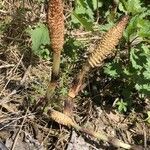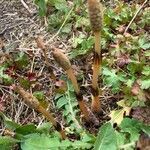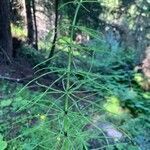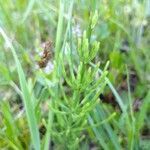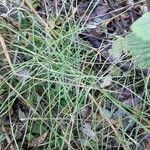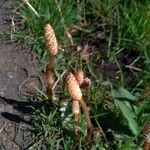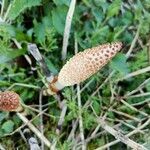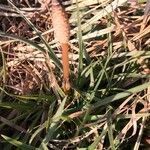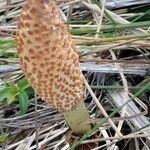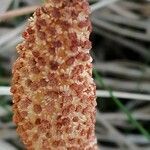Stems annual, dimorphic, the sterile ones 1.5–6(–10) dm, 1.5–5 mm thick, (4–)10–14-ridged, with well developed vallecular cavities and small central cavity ca 1/4 the diameter of the stem; the stomates in 2 broad bands in the furrows, the sheath 5–10 mm, with persistent, brown, free or partly connate teeth 1.5–2 mm; branches regularly whorled at the middle and upper nodes, 3–4-angled, solid, sometimes again branched, the first internode longer than the associated stem-sheath; fertile stems whitish to brownish, precocious and soon withering, to 3 dm, simple, to 8 mm thick, their sheaths 14–20 mm, with large, partly connate teeth 5–9 mm; cones long-pedunculate, 0.5–3.5 cm, not apiculate. Cosmopolitan, somewhat weedy; in moist to moderately dry habitats throughout our range.
Rhizomes pubescent. Aerial stems dimorphic. Sterile stems green, 10-80 cm × 1-5 mm, usually regularly branched with lateral branches simple; ridges nearly smooth; grooves (4)-6-14; sheaths green, up to 10 mm long, teeth as many as grooves; central hollow < 1/2 diam. of main stem; main stem occasionally bearing terminal cones in mid-summer. Fertile stems normally appearing in spring before the sterile stems and dying after shedding spores, pale brown, usually smaller than sterile stems, not branched; sheaths pale brown with darker teeth, up to 14 mm long. Cones (4)-10-40 mm long.
Aerial stems dimorphic; vegetative stems green, branched, 2--60(--100) cm; hollow center 1/3--2/3 stem diam. Sheaths squarish in face view, 2--5(--10) × 2--5(--9) mm; teeth dark, 4--14, narrow, 1--3.5 mm, often cohering in pairs. Branches in regular whorls, ascending, solid; ridges 3--4; valleys channeled; 1st internode of each branch longer than subtending stem sheath; sheath teeth attenuate. Fertile stems brown, lacking stomates, unbranched, shorter than vegetative stems, with larger sheaths, fleshy, ephemeral. 2 n =ca. 216.
Subterranean stems much-branched, dark brown, producing numerous wiry roots in whorls at nodes; tubers sometimes present. Aerial stems dimorphic; vegetative stems 10–40 cm long, with undivided lateral branches in whorls; grooves 3–14; teeth as many as grooves; ultimate tips often 3-angled, 3-leaved. Fertile stems to 25 cm long, pale brown, shorter than vegetative ones, unbranched; leaf sheaths to 1–1.5 cm long, dark brown to black, withering after release of spores. Strobili 10–20 mm long.
A rush like plant. It keeps growing from year to year. It grows 40-60 cm high and spreads 30-45 cm wide. The stems are in rings which are tightly packed. They are 60 cm tall. They are slightly rough and have furrows along them. There are also branching stems which are short lived. The leaves are fine and feathery and light green.

